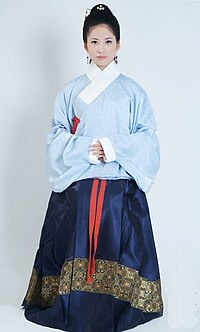| Ruqun | |||||||
|---|---|---|---|---|---|---|---|
 A Chinese lady wearing an aoqun, a style of ruqun popular among Chinese women during the Ming dynasty and Qing dynasty. | |||||||
| Chinese name | |||||||
| Traditional Chinese | 襦裙 | ||||||
| Simplified Chinese | 襦裙 | ||||||
| Literal meaning | Jacket and skirt | ||||||
| |||||||
| Korean name | |||||||
| Hanja | 襦裙 | ||||||
| |||||||
Ruqun (Chinese: 襦裙;) is a set of attire in Hanfu which consists of a short jacket typically called ru (Chinese: 襦; pinyin: rú) worn under a long Chinese skirt called qun (Chinese: 裙; pinyin: qún).[1] However, when use as a general term, ruqun can broadly describe a set of attire which consists of a separated upper garment and a wrap-around lower skirt, or yichang (Chinese: 衣裳; pinyin: yīcháng), in which yi (Chinese: 衣) means the "upper garment" and the chang (Chinese: 裳) means the "lower garment".[2][3]: 27 [4] In a broad sense, ruqun can include the shanqun (Chinese: 衫裙) and aoqun (simplified Chinese: 袄裙; traditional Chinese: 襖裙) in its definition.[5]: 48–50 [6]: 47–50, 54 [4][7]
As a set of attire, the ruqun was worn by both men and women;[2][5]: 48–50 [6]: 47–50, 54 it was however primarily worn by women.[8] It is the traditional Hanfu for the Han Chinese women.[9] The aoqun and/or ruqun is the most basic set of clothing of Han Chinese women in China and has been an established tradition for thousands of years.[6]: 47–50, 54 Various forms and style of Chinese trousers, referred broadly under the generic term ku, can also be worn under the ruqun.
- ^ Wang, Xinyi; Colbert, François; Legoux, Renaud (2020). "From Niche Interest to Fashion Trend: Hanfu Clothing as a Rising Industry in China". International Journal of Arts Management. 23 (1). Retrieved 1 February 2021.
- ^ a b Fang, Zhou (2019). "On the Differences between the "Paofu" and "Ruqun" Types of Men's Costumes in the Cave Murals of Dunhuang--《Dunhuang Research》2019年05期". en.cnki.com.cn. Retrieved 2021-03-12.
- ^ Hua, Mei (2011). Chinese clothing (Updated ed.). Cambridge, United Kingdom. ISBN 978-0-521-18689-6. OCLC 781020660.
{{cite book}}: CS1 maint: location missing publisher (link) - ^ a b Wang, Anita Xiaoming (2018). "The Idealised Lives of Women: Visions of Beauty in Chinese Popular Prints of the Qing Dynasty". Arts Asiatiques. 73: 61–80. doi:10.3406/arasi.2018.1993. ISSN 0004-3958. JSTOR 26585538.
- ^ a b Finnane, Antonia (2008). Changing clothes in China : fashion, history, nation. New York: Columbia University Press. ISBN 978-0-231-14350-9. OCLC 84903948.
- ^ a b c Styling Shanghai. Christopher Breward, Juliette MacDonald. London. 2020. ISBN 978-1-350-05116-4. OCLC 1124593626.
{{cite book}}: CS1 maint: location missing publisher (link) CS1 maint: others (link) - ^ "The Most Classic Hanfu of All Time - 2021". www.newhanfu.com. 2020. Retrieved 2021-04-10.
- ^ Birmingham Museum of Art. "QUICK GUIDE TO HAN DYNASTY CLOTHING". www.artsbma.org. Retrieved 2021-04-10.
- ^ Zeng, Yao (2011). "Chinese influence on western women's dress in American Vogue magazine, 1960-2009". LSU Doctoral Dissertations: 21. doi:10.31390/gradschool_dissertations.3735. S2CID 158262842.